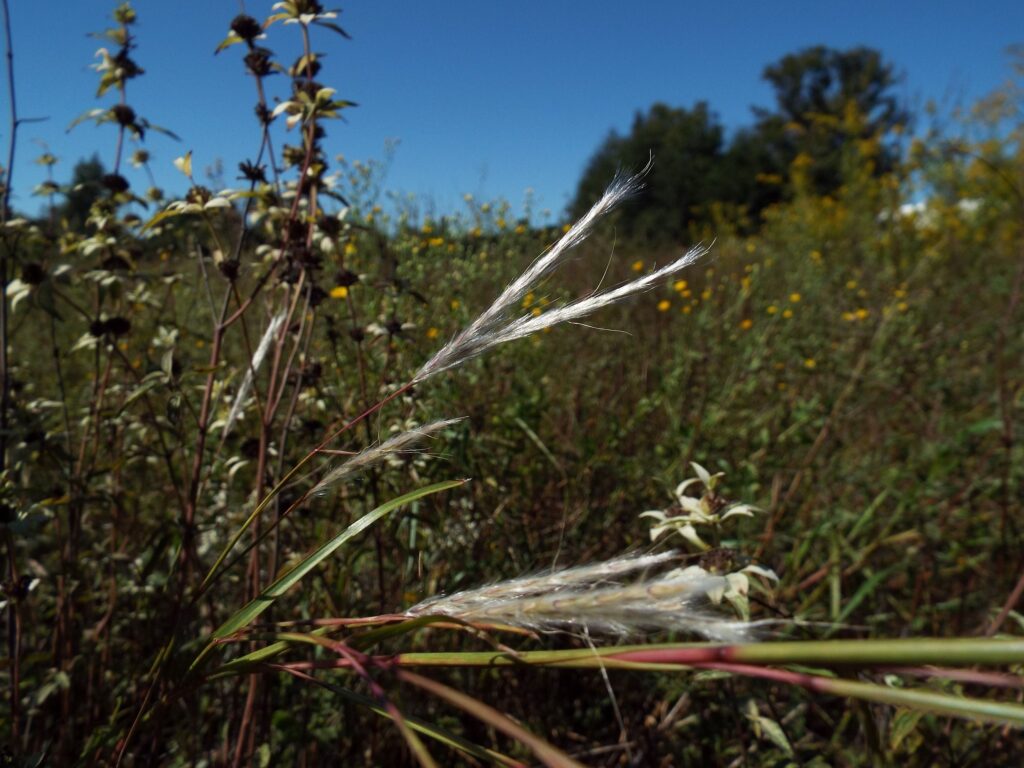






Today for Flora and Fauna Friday we’re examining another one of those ubiquitous Lowcountry plants. It’s a grass known commonly as Broomsedge, Bluestem, or Beard Grass and scientifically as Andropogon.
Each one of these common names describes a different characteristic of the plant. Bluestem describes the color of the foliage: a blue-green grass throughout the growing season. Beard Grass describes the appearance of the plant when it seeds in the fall: a pointed beard of straw covered with white fluff. Broomsedge describes its shape and winter color: an upside down, light brown broom-head. The scientific name of “Andropogon” means “Man’s Beard”, echoing the common name of Beard Grass.
Broomsedge, as I prefer to call it, is not a sedge but a grass. It is a rather diverse genus of grasses that all look rather similar. Its fresh leaves are often glaucous (the scientific way of saying bluish-green) and the more common species in our area can reach up to 5 feet in height. It is a pioneer species, meaning it is one of the first plants to grow in a freshly disturbed habitat. Think of clear cuts, fallow fields, or piles of fill dirt; those are the sorts of habitats that Broomsedge loves to pioneer. Broomsedges also do well in prairie or savanna habitats where regular disturbance by grazing and fire limit the growth of trees. They’re also a very common sight in hayfields and make up a fair portion of the hay the fields produce. In the fall the plants flower and go to seed, releasing hundreds of fluffy white seeds that rely on the wind to carry them to bare earth. Come winter, the grass dies back to its roots but the dried flower stalks from the previous year can persist for months afterwards. Broomsedges provide habitat and food for many species including: Field Sparrows, Rabbits, Sedge Wrens, Katydids, Cotton Rats, Mice, and Deer.
In our area we have quite a few native species but I’m only able to identify the two most common: Broomsedge Bluestem (Andropogon virginicus) and Bushy Bluestem (Andropogon glomeratus), which I have photographed below. The redundantly named Broomsedge Bluestem is our most common species and its appearance is typical of the genus. Bushy Bluestem is also quite common and more distinct in appearance, having large, bushy clumps of flowers rather than having them evenly dispersed across the stem. All our native species are quite similar in appearance and ecology but have slightly different habitat preferences. All provide a valuable ecosystem service in erosion control and soil restoration. Their deep, perennial roots stabilize the soil and bring nutrients up to the top soil from deep in the ground. When they die back each winter they replenish micronutrients and organic matter to tired topsoil and improve growing conditions for other plants. Over time, if grasses are allowed to perpetuate without being harvested for hay, they can restore a once barren field into a meadow, prairie, or savanna. Breathing new life into weathered earth.